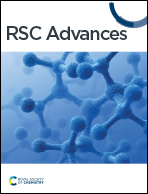Synthesis and immunopharmacological evaluation of novel TLR7 agonistic triazole tethered imidazoquinolines†
Abstract
Toll-like receptors-7 and -8 are expressed abundantly on antigen-presenting cells, and their agonists make potential adjuvant candidates for the development of new efficacious vaccines. In view of the importance of new efficacious imidazoquinoline based adjuvants, herein we have synthesized a focused library of a new class of imidazoquinolines retaining the N-isobutyl substitution of an imidazole moiety as in imiquimod and introduced a 1,2,3-triazolyl moiety upon alkyl substitution at the imidazolemethyne carbon employing triazolyl click chemistry. All the novel analogues were characterized using various spectroscopic techniques and the target specificity of these molecules was determined using HEK TLR7/8 transfected cell lines. TLR7/8 activity and also the molecular docking results correlated primarily to the position of the substituent for aromatic groups and also to the chain length in alkyl substitutions. The immunomodulatory properties of these analogues were evaluated using murine DC activation and also with hPBMC activation markers, cytokines which revealed that these analogues after modification were able to target the TLR7 receptors and also had a pro-inflammatory immune response.



 Please wait while we load your content...
Please wait while we load your content...